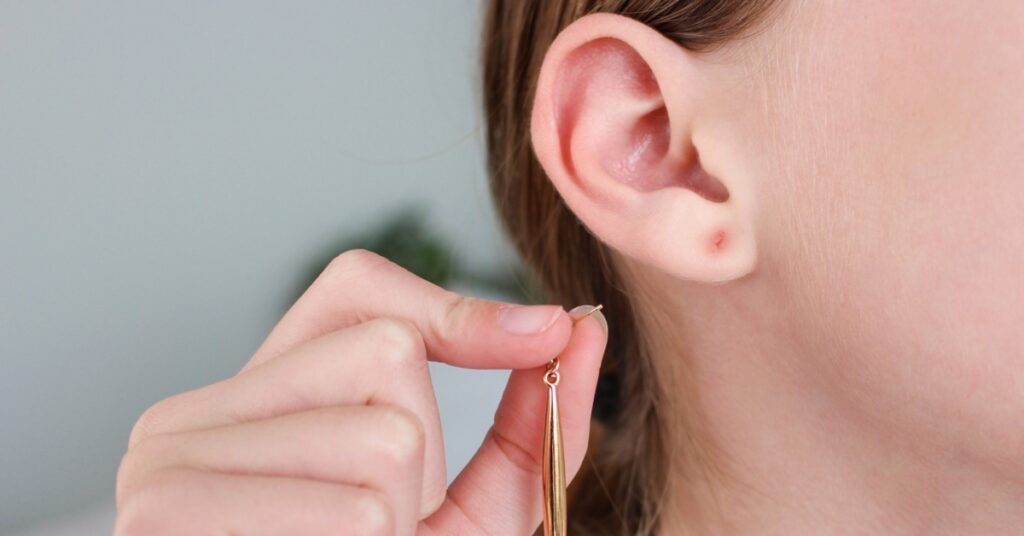Initially, we do not recommend jewelry containing nickel in ear piercings and piercings. When a nickel allergy breaks out, it is a nasty problem for the rest of your life and it can develop little by little with exposure. For many, the most important thing is that, as a child and young person, for example, surgical steel or silver has not caused a problem, but in old age it causes a lot of harm, because the body has been exposed to it little by little.
Symptoms of nickel allergy
A person allergic to nickel reacts very quickly to this unfavorable metal. For many, it may take years after exposure before symptoms begin. The most common inflammation/allergy symptoms that appear quickly are fever, swelling, fluid (tissue fluid and blood), pain, itching, throbbing and hives. For some people, these allergy symptoms are so mild that they think, for example, that earrings only irritate the area of movement, even if it is a more serious allergy.
A nickel allergy that starts later can appear as mild redness, peeling of the skin and swelling. If you notice the onset of the above-mentioned symptoms or their worsening, we recommend that you immediately change your jewelry to nickel-free alternatives. If the situation calms down significantly within 2 weeks, you probably have a nickel allergy. A person with a nickel allergy gets immediate help as soon as the exposure to nickel ends, i.e. unfavorable jewelry materials are removed.
Please note that here we are only talking about a nickel allergy and it is usually easy to rule it out when you try nickel-free jewelry options. There can also be other reasons for irritation in the piercing area (which we won’t cover here), but if you know your jewelry contains nickel and you have complications, we recommend trying our nickel-free jewelry first. You can get help with your problem surprisingly easily, just by changing the jewelry.
How can there be nickel in gold?
Gold itself is a really soft precious metal. The purest 24-carat gold is not suitable for making jewelry, and that’s why we also sell titanium, coated with 24-carat gold. In order to make gold stronger, other metals such as silver, nickel, zinc, palladium, copper, etc. must be mixed with it. Different gold jewelry is made with different concentrations. This is how, for example, the most common 14- and 18-carat gold jewelry is created.
The manufacturers we buy our gold jewelry from make their gold jewelry from nickel-free gold. Our gold has e.g. silver, zinc and copper (brings a rose gold tone). Our jewelry is also cadmium free. Certificates are available on the manufacturers’ websites.
Jewelry materials that contain nickel:
⁃ surgical steel or stainless steel (other names stainless steel, noble steel, roaster) nickel content 10-15%
⁃ Gold jewelry under 24k, unless specifically stated nickel-free (all jewelry in our online store is nickel-free)
⁃ Silver jewelry unless otherwise stated (same as gold depends on other metals mixed)
⁃ jewelry metal (it is not known what it may contain, very harmful to the skin)
⁃ Low-quality titanium (titanium is not automatically nickel-free, but must be implant-grade titanium (Ti-6AL-4V-ELI ASTM F136)
Where can I get more information about nickel content in jewelry?
There is a lot of different information available on the Internet, there you can find studies and official pages where you can find out about nickel concentrations and nickel allergies.
Next, a really good study of pierced jewelry on the market and their nickel content. We recommend reading.
“The fact that now almost half of the examined jewelry parts used for initial installation exceeded the limit value of 0.05 p-% shows that the installers of piercing jewelry either do not know the nickel content of the jewelry they use, do not know the regulations or do not care about them. Importers should also pay attention to the quality of jewelry.”
Source: https://www.hel.fi/static/ymk/…
Although it is an old article, the research is still valid today. The only change is that the limit value for the maximum concentration of nickel in first jewelry has been tightened in 2005 to 0.2 micrograms per square centimeter per week.
Source: https://stm.fi/-/uudet-nikkeli…
For us, safety in piercing jewelry is of primary importance
We want to share and create a transparent conversation about piercing jewelry and the materials used in it.
On our website, you can find direct links to the manufacturers’ pages, where you can read more about the materials they use. Material certificates available from us and manufacturers.
Safe and Nickel-free Piercing Jewelry is brought to you by www.luxjewelle.com























